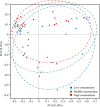Functional assembly of surface microbiota of Ulva fasciata improves nutrient absorption efficiency and growth
- PMID: 39691909
- PMCID: PMC11649579
- DOI: 10.3389/fmicb.2024.1476073
Functional assembly of surface microbiota of Ulva fasciata improves nutrient absorption efficiency and growth
Abstract
Macroalgae growth depends on biologically available nitrogen, such as ammonium and nitrate, making nitrogen the most common growth-limiting factor for macroalgae. However, the role of surface microorganisms in promoting nitrogen transformation and improving nitrogen utilization by macroalgae remains unclear. In this study, 228 bacterial strains were isolated from the surface of U. fasciata, and high-throughput sequencing revealed significant shifts in the composition of surface bacterial communities under different nitrogen concentrations. Key bacterial families such as Rhodobacteraceae and Flavobacteriaceae were identified as essential for nitrogen cycling. Network analysis indicated that Rhodobacteraceae and Flavobacteriaceae were central nodes in microbial interactions. A synthetic microbial community (SynCom2), comprising four strains, significantly increased the biomass, nitrogen, and phosphorus acquisition of U. fasciata, with soluble sugar, protein, and Chlorophyll a level increasing by 23.9-49.2%. Quantitative reverse transcription polymerase chain reaction (RT-qPCR) analysis revealed that compared to untreated control plants, SynCom2 enhanced the expression of key genes associated with photosynthesis (rbcL, 1.04-fold), lipid biosynthesis (accD, 11.21-fold), and growth hormone precursor pathways (wrkY, 9.54-fold). These findings suggest that SynCom2 promotes U. fasciata growth by improving nutrient acquisition and activating growth-related genes.
Keywords: Ulva fasciata; function composition; nitrogen concentration; nutrient efficiency; synthetic community.
Copyright © 2024 Wang, Li, Wang, Wang, Liang, Hu and Liu.
Conflict of interest statement
The authors declare that the research was conducted in the absence of any commercial or financial relationships that could be construed as a potential conflict of interest.
Figures








Similar articles
-
Hyunsoonleella sp. HU1-3 Increased the Biomass of Ulva fasciata.Front Microbiol. 2022 Jan 31;12:788709. doi: 10.3389/fmicb.2021.788709. eCollection 2021. Front Microbiol. 2022. PMID: 35173690 Free PMC article.
-
The role of Ulva fasciata in the evolution of the microbial community and antibiotic resistance genes in maricultural sediments.Mar Pollut Bull. 2021 Feb;163:111940. doi: 10.1016/j.marpolbul.2020.111940. Epub 2020 Dec 24. Mar Pollut Bull. 2021. PMID: 33360612
-
Motility, biofilm formation and associated gene expression in Vibrio parahaemolyticus impaired by co-culture with live Ulva fasciata.J Appl Microbiol. 2022 Jan;132(1):101-112. doi: 10.1111/jam.15175. Epub 2021 Jul 6. J Appl Microbiol. 2022. PMID: 34091972
-
Temporal force governs the microbial assembly associated with Ulva fasciata (Chlorophyta) from an integrated multi-trophic aquaculture system.Front Microbiol. 2023 Oct 5;14:1223204. doi: 10.3389/fmicb.2023.1223204. eCollection 2023. Front Microbiol. 2023. PMID: 37869666 Free PMC article.
-
Antibiotics resistance evolution of isolated Vibrio parahaemolyticus from mariculture under the continuous culture of sub-inhibitory concentrations of Ulva fasciata hydroponic solution.Sci Total Environ. 2023 Feb 10;859(Pt 1):160124. doi: 10.1016/j.scitotenv.2022.160124. Epub 2022 Nov 11. Sci Total Environ. 2023. PMID: 36372171
Cited by
-
Bacterial Supplements Significantly Improve the Growth Rate of Cultured Asparagopsis armata.Mar Biotechnol (NY). 2025 Mar 14;27(2):65. doi: 10.1007/s10126-025-10440-1. Mar Biotechnol (NY). 2025. PMID: 40085266 Free PMC article.
References
-
- Ahemad M., Kibret M. (2014). Mechanisms and applications of plant growth promoting rhizobacteria: current perspective. J. King Saud Univ. Sci. 26, 1–20. doi: 10.1016/j.jksus.2013.05.001 - DOI
-
- Berges J. A., Franklin D. J., Harrison P. J. (2001). Evolution of an artificial seawater medium: improvements in enriched seawater, artificial water over the last two decades. J. Phycol. 37, 1138–1145. doi: 10.1046/j.1529-8817.2001.01052.x - DOI
LinkOut - more resources
Full Text Sources

